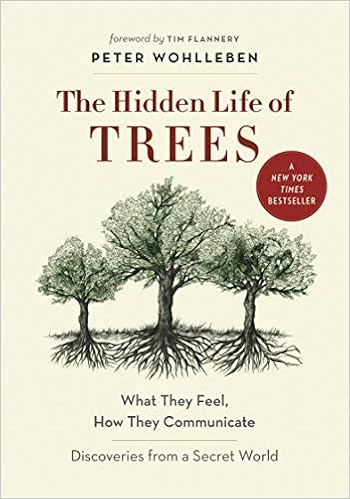May Online Book Club: The Hidden Life of Trees, by Peter Wohlleben
May Online Book Club: What is it?

Love the idea of a book club, but you don’t have time to attend meetings? No problem! We won’t have meetings, but anyone who reads or listens to that month’s title, either with physical copies or digital copies, can participate in our online discussion boards on Facebook and our blog posts. If you’re busy, but love to read, this could be the perfect Book Club for you! Join us and keep the conversation going! The May Online Book Club title is The Hidden Life of Trees: What They Feel, How They Communicate. Discoveries from a Secret World by Peter Wohlleben.
About The Hidden Life of Trees
From Hoopla: In The Hidden Life of Trees, Peter Wohlleben shares his deep love of woods and forests and explains the amazing processes of life, death, and regeneration he has observed in the woodland and the amazing scientific processes behind the wonders of which we are blissfully unaware. Much like human families, tree parents live together with their children, communicate with them, and support them as they grow, sharing nutrients with those who are sick or struggling and creating an ecosystem that mitigates the impact of extremes of heat and cold for the whole group. As a result of such interactions, trees in a family or community are protected and can live to be very old. In contrast, solitary trees, like street kids, have a tough time of it and in most cases die much earlier than those in a group. Drawing on groundbreaking new discoveries, Wohlleben presents the science behind the secret and previously unknown life of trees and their communication abilities; he describes how these discoveries have informed his own practices in the forest around him. As he says, a happy forest is a healthy forest, and he believes that eco-friendly practices not only are economically sustainable but also benefit the health of our planet and the mental and physical health of all who live on Earth.
About Peter Wohlleben
From Amazon: 
Peter Wohlleben spent more than 20 years working for the forestry commission in Germany before leaving to put his ideas of ecology into practice. He now runs an environmentally-friendly woodland, where he is working toward the return of prim eval forests, as well as caring for both wild and domestic animals. Wohlleben has been celebrated for his distinctive approach to writing about nature; he brings to life groundbreaking scientific research through his observations of nature and the animals he lives among. His first work translated to English, The Hidden Life of Trees, is an international bestseller. The Library owns several of Mr. Wohlleben’s other books, if you’d like to check them out as well.
Readalikes for The Hidden Life of Trees
Discussion questions for The Hidden Life of Trees
From the publisher’s Reading Group Choices:
1. When asked why Wohlleben chose to anthropomorphize trees, he said, “I use words of emotion to connect with people’s experience. Science often takes these words out, but then you have a language people can’t relate to and can’t understand.” In what ways is the anthropomorphism of trees effective in The Hidden Life of Trees?
2. The Hidden Life of Trees became a surprise bestseller, earning a place on the New York Times and many regional bestseller lists. What is it about the present that makes nature a popular topic right now?
3. Fungi, while functioning as the “wood wide web” for trees, can allow them to communicate and share crucial survival information. However, they can also damage trees by invading the bark and causing rot. How does this relationship reflect or parallel the one that humans have with the Internet?
4. Wohlleben mentions how a number of forest conservationist methods that help trees in the short-term actually damage a forest’s health in the long-term. In the forest that he works with in Hümmel, he has banned machines and only allows log removal by horses. Is technological advancement working with nature or against it?
5. When a woodpecker drills holes into a tree’s bark, the tree is then susceptible to rot or an invasion of fungi. On the other hand, birds play an integral role in plant reproduction by spreading seeds over long distances. How would you describe the complex relationship between animals and trees: Good, bad, or neutral? Why?
6. Western society places more of an emphasis on the individual, whereas Eastern society values a more collective culture. In terms of the way in which trees care for themselves and others, where do they fall in this spectrum and why?
7. In the first chapter called “Friendship,” Wohlleben describes himself being profoundly inspired when he observes that what he initially took for stones were actually remnants of a rotting stump that were kept alive by its neighbouring trees. Is there a significant tree or forest area that has affected your life?
8. What is the most important lesson that human society can adopt from the life of trees?
9. What misconceptions did you have about trees before reading this book? How did it feel to have your perspective change?
10. Wohlleben writes that people are more physiologically relaxed when journeying through a deciduous forest due to the chemical signals the trees release. However, this effect is absent in a walk through a coniferous forest. • Have you experienced this difference? • Which forest do you prefer to walk through and why?
Conclusion
Remember to tell us what you think! Comment on this post or on Facebook and let us know your thoughts about The Hidden Life of Trees.


